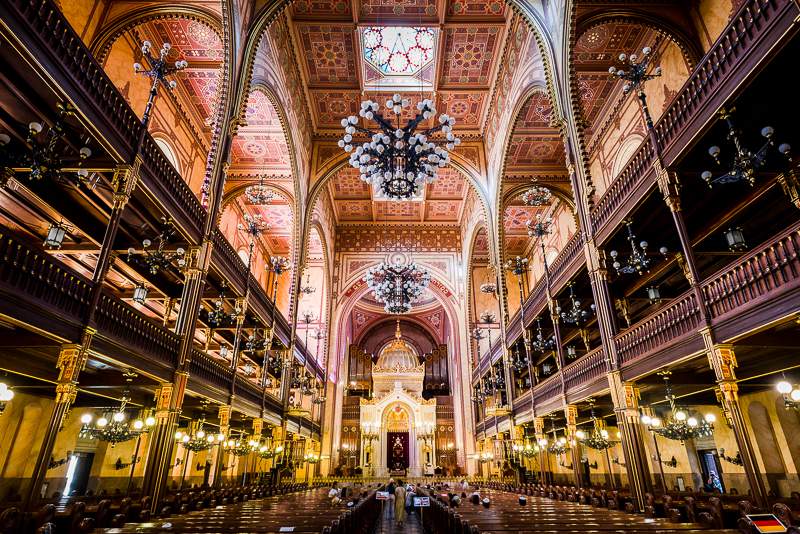12+1 facts about the Dohány Street Synagogue
It can easily be said that there is a historically important building around each corner in Budapest. One of these is the Dohány Street Synagogue, which has become a popular touristic destination and attraction, but there is much more to it than just pretty windows and gloomy history. The following is a collection of some of the most interesting and important facts about the Synagogue.
1) The Dohány Street Synagogue is the largest synagogue in Europe and the second largest in the world. The building is 75 metres long and 27 metres wide. It seats almost 3000 people: 1492 men and 1472 women, plus there are standing places. Tourists are allowed to visit ceremonies as well, given that they respect the traditions.
2) Even before the construction of the Dohány Street Synagogue began, people could pre-order seats. This meant that some seats were reserved for them and only they could use those places. Later, these could be sold.
3) During the early days of the Second World War, the Dohány Street Synagogue was used as the German Radio’s base and as a stable.
4) The most dominant stylistic elements are in Moorish style, but we can notice Byzantine, Romantic and even Gothic design features. The designer of the Synagogue was Ludwig Förster, who designed the Synagoge Tempelgasse in Vienna (it has been demolished since) and the Synagogue of Miskolc. Since the designers and architects of the synagogue were not Jewish people, it resembles Christian basilicas, almost looking like an adaptation of early Christian basilicas.
5) Above the front gate, there is a rose-window, which is the church’s main source of light. The windows on each side of this resemble the two tables on which Moses has written the Ten Commandments.
6) The Central Synagogue in Manhattan, New York City, is almost a true and exact copy of the Dohány Street Synagogue.
7) Interestingly, the Dohány Street Synagogue was built in five years, while its 1991 renovation alone took five years to finish.
8) As it is a Jewish custom to keep Torah scrolls in the ark of the synagogue, the Dohány Street Synagogue contains some as well. A lot of these are from synagogues that were destroyed during the Holocaust.
The Torah scrolls inside the Ark9) The Dohány Street Synagogue differs from other synagogues in the fact that it has pipe organs (Franz Liszt once played the 5000 pipe organ) and a cemetery. It is not customary to have a cemetery next to a synagogue, but the circumstances during WWII asked for the establishment of one. Between 1944 and 1945 January, approximately 8000-10000 people have died in the ghetto where the Synagogue is found. Two thousand of the deceased were buried there.
10) A peculiarity of the Dohány Street Synagogue is that it is not aligned with the street. According to religious laws, all synagogues must face east, where Jerusalem is, so that is why the front of the Dohány Street Synagogue is not lined up with the street.
11) Originally, women could only sit in the upper galleries, but ever since WWII has ended, they are allowed to sit in the aisles too. However, when the synagogue is filled during big events and holiday celebrations, the old-fashioned seating order prevails.
12) During Sabbath, no work and no fire are allowed, which means that using electricity and operating heating systems is forbidden for Jews. This is why the caretaker of the Dohány Street Synagogue cannot be Jewish, nor can a Jew play the organ on Sabbath. Also, music cannot be played inside the synagogue, so this was solved the following way: the organ and the choir are separated from the ‘sacred’ sections, thus the music comes from ‘outside’.
+ 1 In the 18th century, one of the biggest marketplaces was the Rak-piac known otherwise as Kirakodó tér, which is the Széchenyi István tér today. This is where the Jews came to from Óbuda to engage in trade. Gradually, the square became the most important trade centre of Lipótváros, so the Jewish community moved the essential offices of trade here. The wealthier Jews decided to move into the surrounding streets from the 6th and 7th districts, but they still had to visit the Dohány Street Synagogue. However, the Synagogue was too far away, so the Jews there decided to build another synagogue nearby. For this purpose, the Jewish community got an empty lot near the Parliament for free from the city. The plan was to build a synagogue almost as big as the Saint Stephen Basilica, but it proved to be too expensive, so they gave up on it.
You can visit the prayers if you respect the traditions and your clothing is in accord with them. The prayer times during winter time are from 17:00 on Fridays and from 09:30 on Saturdays. In the summer, the Friday prayers start at 18:00 and the Saturday prayers start at 09:30.
featured image: Guavin Pictures
Ce: bm
Source: Daily News Hungary
please make a donation here
Hot news
What happened today in Hungary – 26 July, 2024
Drama: number of births in a 20-year low in Hungary
Yay or nay? – 6 odd Hungarian delicacies that make our skin crawl
Budapest tourism “exploded” this past weekend
Container transport in Budapest may stop: How will this affect Hungarian economy?
Minister: Hungary will protect its territory by every means possible




